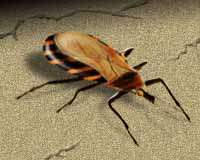Scientists uncover transfer of genetic material between blood-sucking insect and mammals

(PhysOrg.com) -- Researchers at The University of Texas at Arlington have found the first solid evidence of horizontal DNA transfer, the movement of genetic material among non-mating species, between parasitic invertebrates and some of their vertebrate hosts. The findings are published in the April 28 issue of the journal Nature.
Genome biologist Cédric Feschotte and postdoctoral researchers Clément Gilbert and Sarah Schaack found evidence of horizontal transfer of transposon from a South American blood-sucking bug and a pond snail to their hosts. A transposon is a segment of DNA that can replicate itself and move around to different positions within the genome. Transposons can cause mutations, change the amount of DNA in the cell and dramatically influence the structure and function of the genomes where they reside.
"Since these bugs frequently feed on humans, it is conceivable that bugs and humans may have exchanged DNA through the mechanism we uncovered. Detecting recent transfers to humans would require examining people that have been exposed to the bugs for thousands of years, such as native South American populations," Feschotte said.
Data on the insect and the snail provide strong evidence for the previously hypothesized role of host-parasite interactions in facilitating horizontal transfer of genetic material. Additionally, the large amount of DNA generated by the horizontally transferred transposons supports the idea that the exchange of genetic material between hosts and parasites influences their genomic evolution.
"It's not a smoking gun, but it is as close to it as you can get," Feschotte said
The infected blood-sucking triatomine, causes Chagas disease by passing trypanosomes (parasitic protozoa) to its host. Researchers found the bug shared transposon DNA with some hosts, namely the opossum and the squirrel monkey. The transposons found in the insect are 98 percent identical to those of its mammal hosts.
The researchers also identified members of what Feschotte calls space invader transposons in the genome of Lymnaea stagnalis, a pond snail that acts as an intermediate host for trematode worms, a parasite to a wide range of mammals.
The long-held theory is that mammals obtain genes vertically, or handed down from parents to offspring. Bacteria receive their genes vertically and also horizontally, passed from one unrelated individual to another or even between different species. Such lateral gene transfers are frequent in bacteria and essential for rapid adaptation to environmental and physiological challenges, such as exposure to antibiotics.
Until recently, it was not known horizontal transfer could propel the evolution of complex multicellular organisms like mammals. In 2008, Feschotte and his colleagues published the first unequivocal evidence of horizontal DNA transfer.
Millions of years ago, tranposons jumped sideways into several mammalian species. The transposon integrated itself into the chromosomes of germ cells, ensuring it would be passed onto future generations. Thus, parts of those mammals' DNA did not descend from their common ancestors, but were acquired laterally from another species.
The actual means by which transposons can spread across widely diverse species has remained a mystery.
"When you are trying to understand something that occurred over thousands or millions of years ago, it is not possible to set up a laboratory experiment to replicate what happened in nature," Feschotte said.
Instead, the researchers made their discovery using computer programs designed to compare the distribution of mobile genetic elements among the 102 animals for which entire genome sequences are currently available. Paul J. Brindley of George Washington University Medical Center in Washington, D.C., contributed tissues and DNA used to confirm experimentally the computational predictions of Feschotte's team.
When the human genome was sequenced a decade ago, researchers found that nearly half of the human genome is derived from transposons, so this new knowledge has important ramifications for understanding the genetics of humans and other mammals.
More information: www.nature.com/nature/journal/ … ull/nature08939.html
Provided by University of Texas Arlington
















